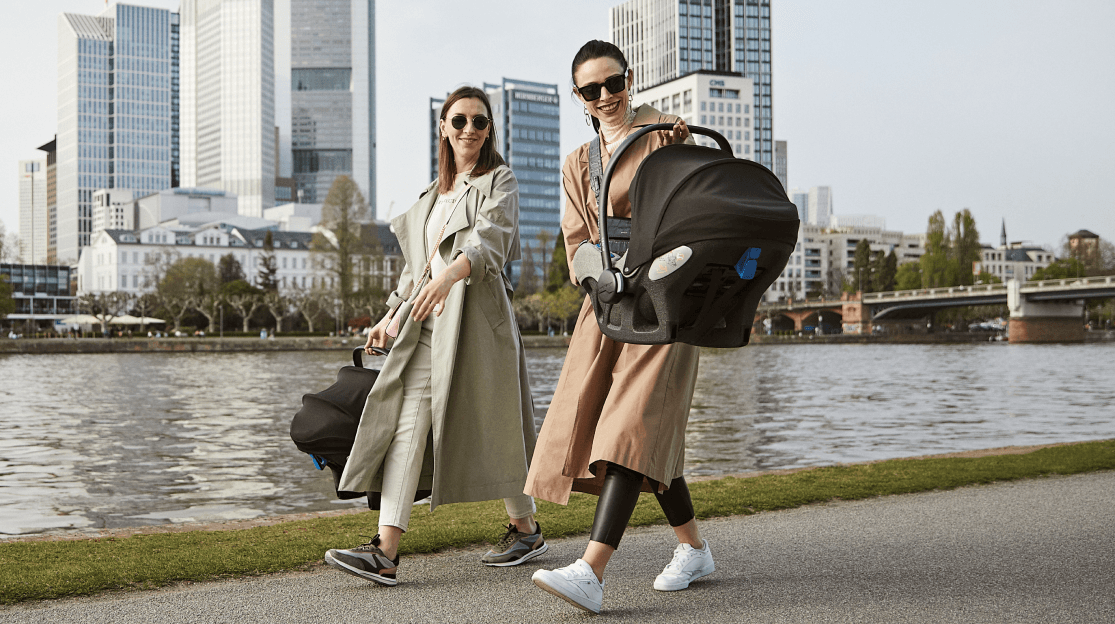
A toddler on a train, underground, bus, taxi – how to safely transport children by public transport?
Traveling with a child means not only driving your own car but also using public transport vehicles. Unfortunately, for many parents, traveling by bus, tram, or train is associated with considerable stress. Wondering how to do it efficiently and safely? You can find out everything in our article!

Contents:
- Safe transportation of children in public transport vehicles
- A child in a taxi
- With a child for longer distances – on the train and bus
Safe transportation of children in public transport vehicles
Let’s start with how to transport a child over short distances in the city. In the underground, bus, or tram, it is best to transport the toddler in a stroller. However, to make your journey as safe as possible, you should follow a few simple rules. First of all, we never put the stroller sideways facing the direction of travel, because it is the least stable in this position. Place the stroller with the backrest facing the direction of travel, and the gondola to the front. During the trip, we put the brake on and put the stroller in the designated place. If left in the passage, it will not only hinder movement around the vehicle, but also pose a threat to the child and other passengers.
Before getting into the vehicle, it is worth making sure that the child is correctly fastened in the seat belts, and while driving, hold the stroller by the handle to give it more stability. It is also very important to be careful when entering and exiting. It is best to enter the bus, underground or tram in the front, and leave it in the back (parent first, then stroller). Otherwise, your toddler may fly forward or the front wheels may become jammed in the gap between the sill and the curb.
Recently, traveling with a child has become easier as low-floor vehicles are almost a standard in large cities. Many buses also have a kneeling function, i.e., lowering the floor to make it easier for a person with a stroller to enter the vehicle. In such cases, the driver should be informed about the willingness to get on or off with the special button. It is also worth knowing that the door closest to the place for transporting strollers is second to the front of the vehicle. You can recognize them by the pictogram sticker.
A child in a taxi
According to the regulations, a child can be transported without a child seat in a licensed taxi, but in the case of so-called passenger transport (for example, Uber, Bolt) it is already required. However, in accordance with the law does not always mean safe. After all, a taxi journey is no different from a ride in a normal car, and crash test results leave no illusions about the safety of a child transported without a child seat. In the case of infants, it is therefore advisable to take a baby seat with you and fit it in the taxi with the straps for the duration of the journey. The matter becomes a little more complicated with older children, as it is difficult to imagine parents carrying a seat for an older child. In such a situation, it is best to use the services of a taxi company, which gives the opportunity to request a ride with a properly equipped car. Unfortunately, not all of them offer this option, and it is best to request the seat well in advance – a few hours or even the day before. What’s more, you may find that the ride will be slightly more expensive.
With a child for longer distances – on the train and bus
As with taxis, a child seat is optional when traveling by train or intercity bus. In the case of these methods of transport, the transport of a child in a stroller is also often cumbersome or even impossible. So, how to do it safely? Currently, most domestic and international buses are equipped with seat belts. With their help, you can install a baby car seat, so it’s best to take it with you when you go on a trip. Some carriers also offer the possibility of ordering a seat for an older child, but unfortunately this is not a standard.
When it comes to trains, it is possible, in theory, to carry a child in an unfolded stroller, but in practice there is seldom enough space for this. In many cases, the track does not even allow you to reach the designated place or compartment, so there is nothing else to do but leave it in the luggage space at the entrance to the car. In such situations, the baby car seat comes in handy once again; you can comfortably carry the baby and put it to sleep on the adjacent seat. Before leaving, however, it is worth making sure that transporting a toddler in this way does not involve an additional charge.
The railway is trying to meet the needs of people traveling with children, so on PKP Intercity and Pendolino trains, it is possible to book a seat in a family compartment, where there is a bit more space. During the period of increased travel, it is worth doing it well in advance, because their number is limited and they are very popular. Bookings can only be made at the ticket office – unfortunately, it is not possible via the Internet!
Finally, a reminder! Paediatricians recommend that infants spend a maximum of 2 hours a day in a child seat. In the case of longer journeys, which usually occur once in a while, it is the breaks that are very important for the baby, whose body structure is still very different from that of an adult. As a standard, it is recommended that you transport your toddler for a maximum of 2 hours, followed by a break of for example, 20 minutes. However, do not approach this with a watch in your hand. First of all, it is important to maintain the correct rhythm of the child’s sleep. If the route may take many hours, it is worth considering dividing the trip so that you have a night break, which will provide more comfort for the child, driver, and other passengers.




